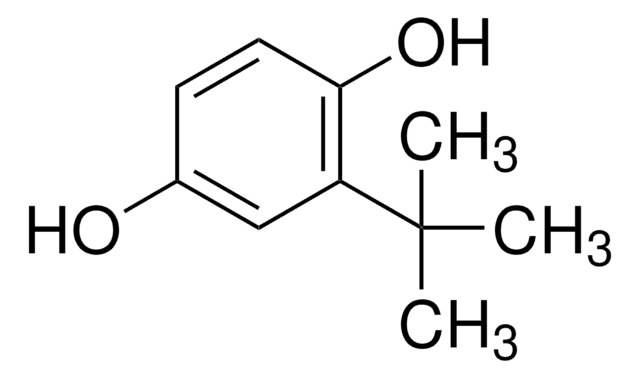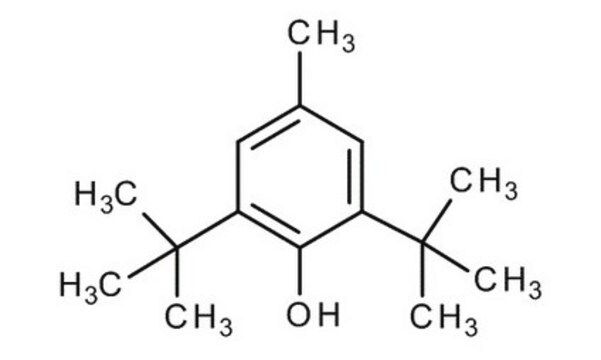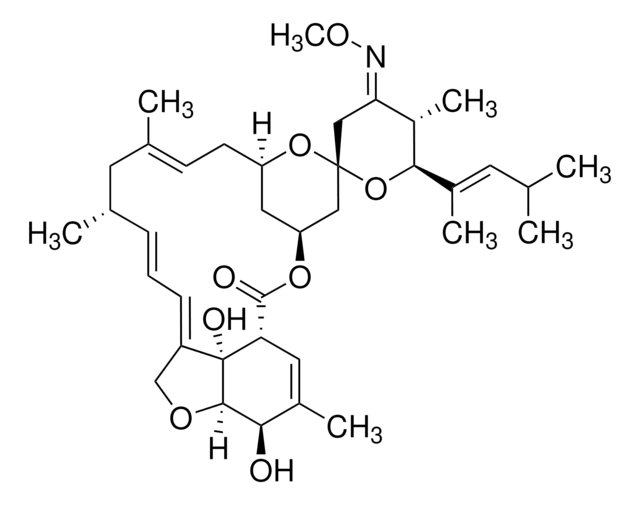PHR1117
Butylated Hydroxytoluene
Pharmaceutical Secondary Standard; Certified Reference Material
Synonym(s):
2,6-Di-tert-butyl-4-methylphenol, 2,6-Di-tert-butyl-p-cresol, BHT, Butylated hydroxytoluene, Butylhydroxytoluene, DBPC
About This Item
Recommended Products
grade
certified reference material
pharmaceutical secondary standard
Quality Level
Agency
traceable to Ph. Eur. B1215000
traceable to USP 1092708
vapor density
7.6 (vs air)
vapor pressure
<0.01 mmHg ( 20 °C)
API family
butylated hydroxytoluene
CofA
current certificate can be downloaded
autoignition temp.
878 °F
technique(s)
HPLC: suitable
gas chromatography (GC): suitable
bp
265 °C (lit.)
mp
69-73 °C (lit.)
application(s)
cleaning products
cosmetics
food and beverages
personal care
pharmaceutical (small molecule)
format
neat
storage temp.
2-30°C
SMILES string
Cc1cc(c(O)c(c1)C(C)(C)C)C(C)(C)C
InChI
1S/C15H24O/c1-10-8-11(14(2,3)4)13(16)12(9-10)15(5,6)7/h8-9,16H,1-7H3
InChI key
NLZUEZXRPGMBCV-UHFFFAOYSA-N
Looking for similar products? Visit Product Comparison Guide
General description
Butylated hydroxytoluene (BHT) is a phenolic antioxidant used as a food additive. It is frequently added to dried cereals, cooking oils and animal foods. BHT is also known to enhance the stability of pharmaceuticals, fat-soluble vitamins and cosmetics .
Application
Analysis Note
Other Notes
Footnote
Recommended products
related product
Signal Word
Warning
Hazard Statements
Precautionary Statements
Hazard Classifications
Aquatic Acute 1 - Aquatic Chronic 1
Storage Class Code
11 - Combustible Solids
WGK
WGK 2
Flash Point(F)
260.6 °F - open cup
Flash Point(C)
127 °C - open cup
Choose from one of the most recent versions:
Already Own This Product?
Find documentation for the products that you have recently purchased in the Document Library.
Customers Also Viewed
Protocols
Phenolic Antioxidants are added to polyers for controlling their degradation process. Irgafos 168, Irganox 1010, Ethanox 330, Irganox 1076, BHT, and Irgafos 168 are often used as antioxidants to prevent the degradation of polypropylene polymer formulations. This HPLC method is for the quantitation of an additive or mix of additives in a polymeric material.
Our team of scientists has experience in all areas of research including Life Science, Material Science, Chemical Synthesis, Chromatography, Analytical and many others.
Contact Technical Service








